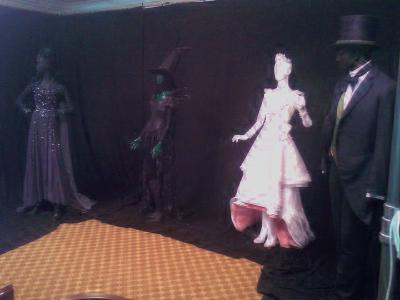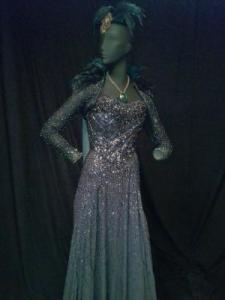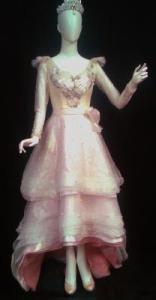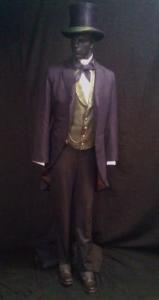By: debbie lynn elias
Gary Jones is no stranger to the world of costume design. Having worked early in his career with the Ringling Bros. circus before moving into theater and film, Jones has seen it all and designed it all. Or had he? Teaming with acclaimed German artist Michael Kutsche, who was initially brought on board OZ as a character designer before being asked by director Sam Raimi to design the witchesf costumes, Jones and his staff of 60 costumers, seamstresses and other textilers designed and created over 2,000 individual costumes for not only the principals, but the inhabitants of Oz, from the Munchkins to the Quadlings, Tinkers, Emerald City citizens and, of course, the Winkies. Making this feat even more astounding is that but for the Winkie guards, no two costumes are the same.

A believer in extensive research as a means to create a foundation for the design of OZ THE GREAT AND POWERFUL, Jones not only looked at the original book illustrations done by W.W. Denslow in 1900, but also integrated touchstones of Evelyn Copelman‘s 1944 illustrations, themselves based on the 1939 classic MGM movie, The Wizard of Oz. By delving into history and the fashion design of the 1880’s to early 1920’s and 30’s, Jones gained even more depth and insight, particularly when it came to creating the costume for James Franco’s Oscar Diggs a.k.a. Wizard of Oz.
At the end of the day, the costumes for all the players, reflect both an historical and literary point of view plus fantasy fashion and drop-dead gorgeous design. With a distinctive Art Deco theme, particularly with Rachel Weisz’ Evanora, there is not only the meticulous use of emerald and black beading, but an architectural structure to her gowns, setting her apart from the “average citizen” and from Michelle Williams’ Glinda who wears three different white gowns throughout the film. Describing the Emerald City and Evanora green as a “mercury green”, Jones was careful to distinguish the light and dark aspects of not only each individual witch/sister, but between them. Interesting is that while at first blush, the costumes of Evanora and Mila Kunisf Theodora have similar cuts, they have very different “feels” or auras to them, helping to set the emotional tone of the characters and story.

When it came to designing the costumes for the citizens in each Ozian land, the design was specific and deliberate. For the Munchkins and Quadlings, “blue collar workers” so to speak, bright, happy colors and fanciful design for “the butchers, the bakers and the candlestick makers.” The Tinkers’ clothing design embodies turn of the 20th Century Old West blacksmiths, cobblers with browns, tans, smears of black and use of leathers and sturdy cottons. Those characters within the Emerald City, of course have more than a few touches of green, but also go from a more carefree feeling to a Wall Street “buttoned up” sensibility with rich, saturated jewel tones representative of money, power. The only costume to be repeated within the entire cast is that for the Winkies and the entire 50 or so guard force who are imposingly attired in Prussian-inspired spit-polish wool fabric, brass buttoned, military dress complete with 18-20 inch high feathered hats. Already standing between 6’6″ and over 7′ tall, hat height was important to Sam Raimi so as to create a truly imposing and overpowering feel.
I had the opportunity to not only look at some of the costume creations up close, but sit down for an illuminating conversation with costume designer Gary Jones. A joy from start to finish, as I quickly learned in this exclusive 1:1 interview, Jones is very open, easy-going, affable, entertaining and knowledgeable, not to mention observant, as he quickly noticed my own emerald and ruby jewelry homage to witches, Evanora and Theodora. . . . .
This is an absolute visual delight to see these extraordinary costumes not only on screen but up close and personal. Personally, I want Evanora‘s dress!
I’m glad! I’m so glad. They’re all favorites. It’s really hard to pick.
This marriage, this partnership, of you and co-designer Michael Kutsche, if the end result is any indication, it must have been heaven.
It’s divine. It really is wonderful. I think we never could have had one without the other. That’s the way it feels and it felt that way the whole time. The drawings, the images and silhouettes that sparked Sam’s [Raimi] vision, they really paid off.
I talked to Sam briefly about the vision and the visuals. I see so much in the production design, including the costuming, and a lot of it harkens back to the 1900-1901 original book illustrations. So many people are fixated on the 1939 movie, but I see so much in the costuming and design of the Munchkins, the Scarecrows, the Winkies, that is taken from the original source material. Did you and Michael look at the original drawings in the Baum books?
I did. But I have to say, and I can’t speak for Michael, the original drawings, although Sam saw them, he didn’t want drawings “like” that for the feeling of the film. They were too dated for him and too period correct for him. I think it’s fair to say that.
Then what you did is not make costumes “like” the early illustrations or even the 1939 movie, but rather capture the elements beautifully within your designs themselves.
And I think that’s where the partnership with Michael has really been astounding. The result was not surprising, but happy, a happy marriage. When we started fleshing things out and I brought my expertise which is definitely dressmaking and period, when I got on board it paid off because we were able to marry the two worlds and bring some of the reality of it to the shapes and fabrications.
Speaking of fabrications, that‘s something that I always love. My first job as a teen was in a fabric store and I used to make all my own clothes so I am very in tune to fabric and always notice the moires, the different cottons, silks, the weaves, the textures, the patterns.
Oh that’s wonderful. Isn’t that cool? Me, too.
In the past, I‘ve asked Catherine Martin if she actually had fabrics woven or dyed to certain specifications for a particular costume and she‘s been very open about it no longer being practical from both a time and economic standpoint. With OZ, the fabrications are so exquisite, so diverse. You have your plain ginghams, cottons, and then the exquisite beadings and iridescent fabric. How do you go about finding and selecting these particular fabrics or did you design the fabrics?
I have to say that some of it comes from my theatrical background. Also, it’s a fact that certain things cling, certain things stand away. For the most part,those [fabric decisions] are pretty cut and dried but I always like to think “what else could we make this out of”. That doesn‘t mean that you do, but it does start you down a road of many different ideas.
And you also have to consider how it‘s going to look on camera which is very different than how it would look on stage.
Absolutely. Absolutely.
I think of the Ginger Rogers feathered dress……it looked good, but the practicality aspect caused some problems.
“The Famed” !! [laughing] Yes, and feathers are still annoying! [laughing] There’s no question about it! They are tough and they make you hot and they do fly around!
You had some very “tame” feathers in OZ.
We had them made for us. We had them made – obviously the animals made them, the birds – but they were made for us and dyed for us in Pennsylvania by a wonderful feather lady that we discovered, who used to be in Manhattan and of course has gone to a farm where she can “pluck” her own. [laughing] But we had that done for us and it turned out to be a really wonderful resource. One of the things that I realized happened with Glinda, without knowing it, we made her finale dress inside out. It wasn’t thought of that way. But that’s what it is. The color is there and then on top of it are all of the layers that you would have done to make it “go out.” That is just a little kismet, really, but that‘s how we got there.

Would you consider to be the most ambitious project you’ve worked on?
Yes, and mainly because the other big movies that I’ve done have either had basically modern dress extras or period background performers, but generally the bulk of those are always armies, so it’s a whole bunch of one army and a whole bunch of another. We had basically 2000 background artists. They are broken up in groups, too, as well. 200 ladies, 200 men in one style of costume. And then another 200 and another 200 in another. But, they are all new fabrications and they aren‘t repeated. None of them are repeats except for the Winkie guards who all by themselves were a problem because they were 6’6″ and taller. [chuckling] There was no way around it!
I want to know how casting found that many taller guys who werenft basketball players.
Exactly! My first thought was to get somebody who knows all the basketball players but it didnft work that way. But, what a thrill they were! Many of them were athletes. Everyone of our background [actors] came every morning. We never had to replace people. They came everyday. Some of them were Los Angelenos but mainly they were from the Detroit area. It was an extraordinary thing. Usually therefs a huge dropout rate with background artists.
You‘re no stranger to costuming after all these decades. As you sit back now and reflect, what is the greatest gift that designing and costuming gives to you?
The greatest gift is when I‘m standing in the fitting room, which is my favorite place, and I see an actor or an actress start to realize who they’re going to be. You can tell the minute it changes. They’re touching things as a character and not as themselves and not even as they “thought” the character would. This could work, this could be it. “Of course I would wear a hat because it balances.” When you see that change it’s thrilling, just thrilling. I genuinely love actors and actresses. And I don’t mean that in any fan way. I love what they do. I love to see them get involved and I love to help make that person come alive. It does happen in the fitting room a lot. Even people who come thinking, “I’m gonna be the evil witch”, and I don’t mean with attitude, but you see them [thinking], “Oh, maybe she doesn’t have to be black black or white white.” But that’s the real gift that I get.
It‘s funny that you say that about the fitting room and watching the actors when they are putting the clothes on because watching James Franco, watching him over the years in such diverse roles – in t-shirt and jogging pants stuck in a rock, then a grungy t-shirted maniacal genius on General Hospital – and now we see him here as Oscar Diggs aka Oz put into this three piece suit that is so transformative, even when the suit is torn in the opening sequence, Diggs states to his assistant, “You have to fix this.” It gives a demeanor to him that we donft normally see. And that suit that you designed for Franco is just so classic.
I’m glad you like it and I’m glad you see that. That was the intention. There were many times over the course of the prep, which we started out here at Western Costume, where everybody would say, “How many costumes is James going to have?” And I’d say, “We’re working on that now.” Eventually Sam [Raimi] and I were talking and Sam said, “What do you think about him, about Oscar?” I showed him the magician’s hat and things. And he said, “What are we gonna do about James?” I said, “I think he has the same thing for all intensive purposes for the whole movie.” He said, “One costume? Really?” I said, “I do. I don’t think we want to be thinking about where he got it, who brought it to him, if he’s been run out of town because he’s an unsuccessful magician, who made it. I don’t think we want any of that. It will sometimes be very clean and very ’up’. Sometimes he’ll come out of the water in it and it’ll dry.” Sam went with it and eventually – I know he did – really realized that it was a good move.

What it also does is allow us to see a great emotional arc in James‘ performance that we don’t normally get to see. We generally see him brash and loud and arrogant and maniacal. But here you have the arrogant facade, the charlatanfs facade and the rundown looking suit but then as he humbles himself, the suit changes. It gets cleaner looking, sharper, but it‘s still the same thing.
It keeps him planted in our mind on earth.
Playing Oscar/Oz is one the best things I‘ve seen James do in terms of his performance range and emotion and I think having him in the one costume played into that.
I’m glad. You‘re making me very happy with what you say because I so didn‘t want to get complicated. You can think, “Well, that makes life easy.” But it didn’t. Nonetheless, it keeps it clean, it keeps it neat and I‘m thrilled that you feel this way and that you noticed it. And then at the end the little spruce up with the green [vest], you just buy it. It didn’t hurt.
Beautiful, beautiful work, Gary! I fully predict that next year we‘ll be hearing your name come Oscar time.
I hope so. I’m so glad you like [the costumes]. I couldn‘t be happier for the movie. We worked hard at it!
#











